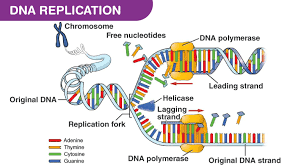DNA REPLICATION-DEFINITION & PROCESS
Definition
DNA replication is the biological process in which two identical replicas of DNA are formed from one original DNA molecule during cell division. The cell possesses the distinctive property of division which makes replication of DNA essential.
Reolication Process
It has three stages i.e. initiation, elongation and termination.
- DNA replication occurs during the S-stage of interphase.
- The structure of DNA is double helix having two complementary strands. During replication, these strands are separated and act as templates for making the new strands of DNA from original DNA molecule. This process is called semi-conservative replication, because the result of DNA replication is two DNA molecules consisting of one new and one old chain of nucleotides.
- As a result of semi-conservative replication, the new helix will be composed of an original DNA strand as well as a newly synthesized strand.
- The separation of the two single strands of DNA creates a ‘Y’ shape called a replication ‘fork’ grows bidirectionally from the origin.
- Each single strand of DNA is a chain of four types of nucleotides which contains a deoxyribosesugar, a phosphate, and a nucleobase. The four types of nucleotide correspond to the four nucleobases namely,
- Adenine
- Cytosine
- Guanine, and
- Thymine, abbreviated as A, C, G and T. Adenine and guanine are purine bases, while cytosine and thymine are pyrimidines. These nucleotides form phosphodiester bonds. Nucleobases are matched between strands through hydrogen bonds to form base pairs.Here Adenine pairs with thymine (two hydrogen bonds), and guanine pairs with cytosine (three hydrogen bonds).

Replication fork
It is created by helicases. The resulting two strands serve as the template for the leading and lagging strands. One of the strands is oriented in the 3’ to 5’ direction (towards the replication fork), called “Leading Strand”. The leading strand is the strand of nascent DNA which is synthesized in the same direction as the growing replication fork.
While, the other strand is oriented in the 5’ to 3’ direction (away from the replication fork), this is called “Lagging Strand”. Its direction of synthesis is opposite to the direction of the growing replication fork. As a result of their different orientations, the two strands are replicated differently. The pairing of complementary bases in DNA (through hydrogen bonding) means that the information contained within each strand is redundant.
6. The enzyme“helicase” which breaks the hydrogen bonds, accommodate in unwinding of DNA at the origin and synthesis of new strands.
DNA polymerase (enzyme) synthesizes the new strands by adding nucleotides that complement each template/ strand. However, a number of proteins are also associated with the replication fork to assist DNA synthesis, but DNA polymerase is most prominent.
List of DNA Replication Enzymes
- Helicase– It separates the two strand of DNA, creates Replication fork and breaks the hydrogen bond.
- DNA polymerase- It synthesizes the new strands by adding nucleotides that complement each template/ strand. It is responsible for catalyzing the addition of nucleotide substrates to DNA in the 5′ to 3′ direction during DNA replication.
- Topoisomerase- Related with overwinding or underwinding of DNA. It relaxes the DNA from its super coiled nature.
- DNA gyrase- It is a type of topoisomerase, relieves strain of unwinding by DNA helicase.
- DNA ligase- It facilitates the joining of DNA strands together by catalyzing the formation of a phosphodiester bond. It plays a role in repairing single-strand breaks in duplex DNA in living organisms. DNA ligase is used in both DNA repair and DNA replication.
- Primase- It is a type of RNA polymerase, provides a starting point of RNA or DNA for DNA polymerase to begin synthesis of the new DNA strand.
- Telomerase- It is a reverse transcriptase enzyme that carries its own RNA molecule which is used as a template when it elongates telomeres. It lengthens telomeric DNA by adding repetitive nucleotide sequences to the ends of eukaryotic chromosomes.
- Single strand DNA binding protein– that binds to single-stranded regions of deoxyribonucleic acid (DNA).
Read more…
WHAT IS CHROMOSOME- AN OVERVIEW
MITOSIS & MEIOSIS- CELL DIVISION
DIFFERENCE BETWEEN PROKARYOTIC AND EUKARYOTIC CELLS
DIFFERENCE BETWEEN PLANT CELL AND ANIMAL CELL
WHAT IS ENZYME- NATURE AND PROPERTIES
CLASSIFICATION OF ENZYMES
you have a great blog here! would you like to make some invite posts on my blog?
sure. i will try.